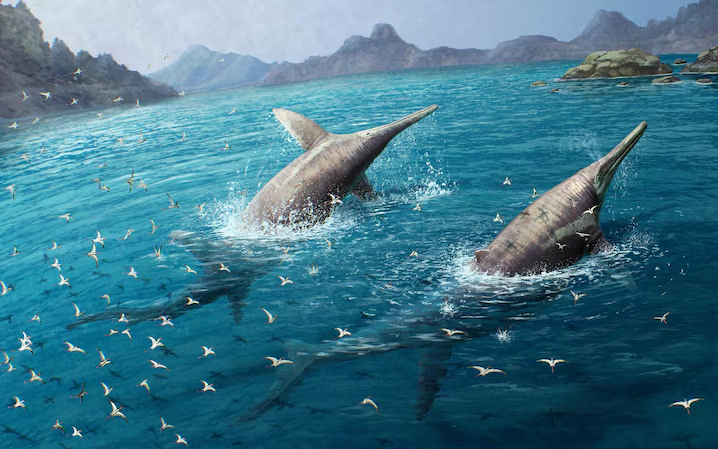A newly identified fossil from England has revealed a jaw-dropping discovery — a marine reptile so massive it may have been one of the largest creatures ever to roam Earth’s oceans. Scientists have named it Ichthyotitan severensis, meaning “giant fish lizard from the River Severn,” and it’s rewriting what we know about prehistoric life beneath the waves.
🌊 A Discovery Millions of Years in the Making
Back in 2016, fossil hunter Justin Reynolds and his daughter Ruby were walking along Somerset’s beaches when they found a huge chunk of fossilized bone sticking out of the cliffside. At first, no one could be sure what it belonged to — but its size hinted it was something extraordinary.
Years later, paleontologist Dr. Dean Lomax, an expert on marine reptiles, compared the fossil to another enormous jawbone found a few years earlier. The pieces matched perfectly. Both were parts of the same type of creature — one never seen before. The discovery was officially published in 2024, confirming a new species: Ichthyotitan severensis.
🦴 How Big Was This Ocean Giant?
So far, scientists have only found fragments of the lower jaw — but even these are over six feet long. By comparing the bones to other giant ichthyosaurs, researchers estimate the animal could have reached 24 meters (around 80 feet) in length.
That’s the size of a blue whale, and several times longer than a killer whale. Imagine a marine predator as long as eight cars lined up — cruising through ancient seas nearly 200 million years ago.
🐋 The Apex Predator of the Triassic Seas
During the late Triassic period, ichthyosaurs ruled the oceans just as dinosaurs dominated the land. Ichthyotitan would have been one of the ultimate predators of its time — possibly feeding on fish, squid, and smaller marine reptiles.
Researchers believe these animals were fast, powerful swimmers with large eyes for spotting prey in the deep. They likely used their elongated jaws to snatch and swallow prey whole, similar to how modern whales hunt.
But the story of Ichthyotitan also raises new questions. How did such enormous animals survive in the ancient oceans? Scientists suggest the answer lies in a surge of marine productivity during that era — with booming plankton populations feeding a chain of life large enough to sustain oceanic giants.
⏳ A Creature Lost to Time
Despite their dominance, ichthyosaurs disappeared long before the rise of the dinosaurs we know best. A mass extinction at the end of the Triassic wiped out many large marine species. While smaller ichthyosaurs survived for millions of years afterward, none ever grew as large as Ichthyotitan severensis again.
This find gives scientists an incredible glimpse into that lost world — a time when England’s cliffs were part of a warm, shallow sea filled with leviathans.
🔍 Why This Discovery Matters
Every fossil tells a story, but this one does more — it challenges our understanding of evolution, ocean ecosystems, and how gigantic animals evolved long before whales existed.
Dr. Lomax calls the discovery a “once-in-a-lifetime” moment. “Finding two matching fossils from such a rare and gigantic creature, discovered years apart by different people — it’s extraordinary,” he said.
For now, Ichthyotitan severensis remains a mystery built from just a few fossil fragments. But scientists believe there’s more waiting to be found beneath the cliffs of Somerset — perhaps even a complete skeleton that could reveal the true scale of this ancient sea monster.
⚡ Quick Facts
- Name: Ichthyotitan severensis
- Meaning: “Giant fish lizard from the Severn”
- Age: ~200 million years (Late Triassic)
- Length: Up to 24 meters (≈ 80 feet)
- Location: Somerset, England
- Group: Ichthyosaurs (marine reptiles, not dinosaurs)

